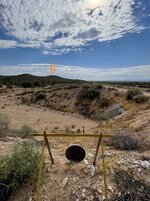WKR
WKR
- Joined
- Jun 14, 2019
- Messages
- 2,036
I have an upcoming hunt where I expect there to be opportunities at long range. So I have been implementing a self imposed cold bore challenge everyday, once I become comfortable at the set distance I move the target back and resume the daily cold bore shot.
This week, starting Sunday, im at 750. Yesterday I go out and hit the cold bore and a follow up just for good measure, today....whiffed on the cold bore and a follow up, Yesterday was a consistent 5mph wind that was easier to call then today with a 6mph that was variable and I over compensated both times I shot.
I wonder though if my target is to small? Its a 8×12 ipsc, which actually is a good size representation of a deers vitals but at 750, if I miss its hard sometimes to see which side of the plate I'm on and what to correct. Should I step up to a bigger plate and paint a kill zone size aiming point ?
Anyhow, I'd like to hear some recommendations on what more I should implement into the training regiment and also what some of you guys do to train for upcoming hunts.
I am training field positions too, but keep that 600 and in. The cold bore stuff is if I get an opportunity where I can be prone or fully supported
This week, starting Sunday, im at 750. Yesterday I go out and hit the cold bore and a follow up just for good measure, today....whiffed on the cold bore and a follow up, Yesterday was a consistent 5mph wind that was easier to call then today with a 6mph that was variable and I over compensated both times I shot.
I wonder though if my target is to small? Its a 8×12 ipsc, which actually is a good size representation of a deers vitals but at 750, if I miss its hard sometimes to see which side of the plate I'm on and what to correct. Should I step up to a bigger plate and paint a kill zone size aiming point ?
Anyhow, I'd like to hear some recommendations on what more I should implement into the training regiment and also what some of you guys do to train for upcoming hunts.
I am training field positions too, but keep that 600 and in. The cold bore stuff is if I get an opportunity where I can be prone or fully supported
Last edited:



